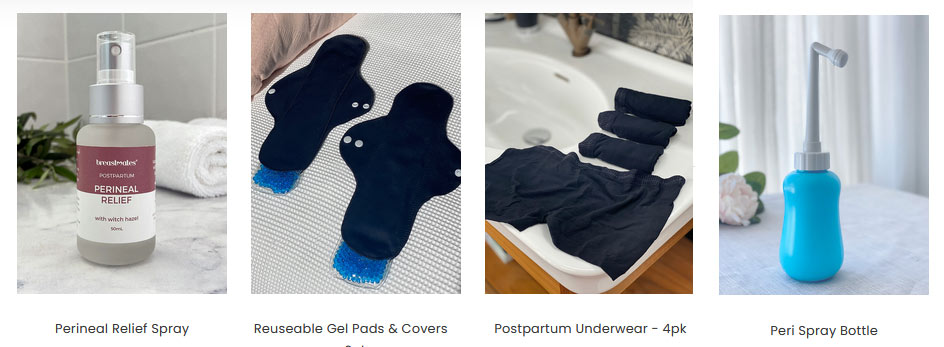Why I care about your perineum (and you should, too)
Caution: Taboo topic ahead! Chances are you’ve heard furtive whispers about things that can happen during labour… Words like “forceps” and “ventouse” and “dilated to 10cm” and “third-degree tear” are mystifying to those who haven’t gone through antenatal class (and sometimes to those who have). The truth is, if you’re having a vaginal or “natural” birth, sometimes in order to get your baby out, some extra-uncomfortable things might be happening down below.

While there’s no way to know ahead of time what your birth will be like, there are things you can to do prepare your body for labour, and one of those things is taking time to engage in perineal care. That is, learning about your perineum and getting it ready for the biggest stretch of its lifetime – the 10cm it needs to dilate in order for you to push your baby out. 85% of women experience some degree of tearing to the perineum during labour, and about 69% require stitching to repair this tear.
Where is my perineum, exactly?
Your perineum is the stretchy band of tissue between your vulva and your anus. You might have a short perineum or a long perineum – no two perinea are the same. (Yes, “perinea” is the plural of “perineum”. I had to look that up so you don’t need to. I can’t think of any other time either of us will need to know that word than right here in this paragraph.) Go on and get out a hand-mirror and take a look at yours; I won’t tell.
What happens to my perineum during labour?
During labour, your perineum gets stretched and strained as you bear down to push out your baby. You will feel a lot of pressure on your perineum, particularly during the time when your baby is crowning – when the head is being pushed out, which many women call the “ring of fire” as it can feel like a stinging sensation. Your perineum may tear as your baby is born, but your midwife will try to prevent this by giving you instructions on when and how to push in order to minimise tearing if possible.
Your LMC might need to make a small cut in your perineum, called an episiotomy, in order to widen the area that stretches while you’re giving birth. You should talk to your LMC about what criteria they use to make the decision whether to risk a tear or perform an episiotomy, and understand the consequences of each.
If your perineum tears, your LMC will determine whether the tear needs stitches. There are four “degrees” of perineal tears:
- 1st degree: A shallow tear to the skin, which may not need stitches.
- 2nd degree: A tear to the skin and muscle, which will likely need stitches.
- 3rd degree: A tear through the perineal muscles and into the anal sphincter (the ring-shaped muscle around the anus). This will need stitches.
- 4th degree: Very uncommon; a tear that goes through the anal sphincter and into the rectum. This is considered to be a severe injury and will need extensive stitching.
The majority of women have a 1st or 2nd degree tear. Very few mums (less than 1%) have a 3rd or 4th degree tear.
If you do need stitches, your LMC will give you a local anaesthetic before using a special needle and dissolvable thread to stitch you up. Stitching shouldn’t hurt because of the anaesthetic, but if it does hurt, tell your LMC as you may need more anaesthetic. Being stitched feels like a pulling sensation and can be uncomfortable. If you’ve had an epidural, you might not need local anaesthetic when you’re being stitched.
What do I need to do to get my perineum ready for labour?
Many mums-to-be try perineal massage, which is best done during the last month of pregnancy, as long as your LMC says it is safe for you to do so. This involves gently massaging and stretching the perineum with your thumb. A pelvic floor physio or your LMC can help you learn the technique, and there are instructions online, but the gist of it is:
- Talk to your LMC to be sure perineal massage is safe for you to try, and to get any guidelines or tips.
- Make sure your hands are clean and dry, and that your nails are short.
- Lean back on your bed with your knees spread wide.
- Apply a few drops of lubricant or perineal massage oil that we stock by Weleda (avoid anything that is unsafe to be used on your genitals) to your perineum and to your thumb.
- Insert your thumb into your vagina up to the first knuckle – not your whole thumb – and apply gentle pressure downwards on your perineum, toward your anus. Move your thumb in a U-shape from left to right, maintaining gentle pressure. You should feel gentle stretching, but it shouldn’t be painful.
- Continue massaging for three to five minutes, and repeat once a day until you give birth.
Perineal massage may reduce the risk of tearing during labour, although it is not a guarantee. If perineal massage is causing you any discomfort, injury, inflammation, irritation, or pain, stop doing it and tell your LMC.
How can I prevent tearing while I’m giving birth?
Unfortunately, there’s no tried-and-true way to guarantee you won’t tear during labour. Your best preparation is to try perineal massage during the last month of pregnancy, and then during labour, to listen to your LMC when they tell you when and how to push, as they can see what’s going on right at the “business end” of things. Pushing in a slow, controlled way during the final stages can help.
Some labour positions, like side-lying, standing, kneeling, or being on your hands and knees can help reduce the risk of tearing. Additionally, avoiding remaining in the same sitting or squatting position can help – move as much as you are able to and let gravity do as much work as possible, so your pelvic floor doesn’t have all of the pressure. Sitting on a balance ball rather than in a chair or on the bed can also be helpful.
Your LMC may massage your perineum during labour, or may hold a warm compress on your perineum while you’re pushing, or even support it with their hand. Although it might feel odd or awkward, remember, they’ve seen it all and this is a normal thing for your LMC to do. If at any point you feel uncomfortable with what is happening, speak up, because you have the right to say what happens to your body.
Ouch, I needed stitches! What now?
Depending on what “degree” of tear you had, and how much repair your LMC needed to do (how many stitches you needed and through how many layers of muscle and skin), it might take a while for your perineum to heal – if could be several weeks. Your LMC will give you advice and guidance on this. They’ll also let you know when it’s safe to have sex again.
To help a tear heal, try these things:
- Keep the tear as clean and dry as possible. Change your maternity pad often, shower every day, and pat the area dry or air-dry after bathing or showering.
- When using the toilet, pour warm water over your vaginal area to help ease any stinging you feel from urine (our Peri Spray Bottle makes this easy).
- When pooping, you might want to place a pad of folded toilet paper on the cut and press gently to relieve pressure when you’re bearing down to release a bowel movement. Laxatives may also help as they can make bowel movements softer and easier to pass.
- After using the toilet, don’t rub the area with toilet paper – blot gently with wet toilet tissue and then pat dry with clean, dry toilet tissue.
- Use a peri-bottle to rinse your vulva and perineum on the toilet or in the bath/shower.
- When resting, lay on your side as much as possible, and avoid laying or sitting in positions which place pressure on the perineum. You may want to use a donut-shaped cushion to sit on to avoid putting pressure on your perineum when you sit.
- Avoid high-impact exercise until your perineum is healed. Skip the squats, sit-ups/crunches, and lifting for now.
- Do your pelvic floor exercises when your LMC says it’s safe to do so.
- Give your perineum air once or twice a day – take off your undies, lay on your side, and let the fresh air circulate.
- Talk to your LMC about safe pain relief you can take to help with any pain you are feeling from your tear.
- Use our freezer Gel Pads and place cooling relief on your perineum. Or put maternity pads in the freezer before wearing them for some cool relief with added witch hazel spray
What if things don’t feel right down there?
Your perineum should heal on its own over time, but there are reasons you should get it checked out if you suspect something isn’t quite right. Get in touch with your LMC or your GP if you notice any of these:
- If your stitches feel more painful
- If they haven’t dissolved away in the time frame your LMC said they would
- If your tear reopens or if the stitches don’t hold
- If the tissue around the stitches is red, inflamed, swollen, or is oozing/bleeding
- If you have smelly discharge
- If sex feels very uncomfortable or your tear reopens during sex
Am I likely to tear again if I have another baby?
Having a small tear during labour doesn’t mean you’ll tear next time, or that you can’t/shouldn’t have a vaginal birth next time. However, if you have had a 3rd or 4th degree tear, you may be at risk for a future tear and, in some extremely rare cases, it might be recommended that you have a C-section rather than a vaginal birth. Talk to your LMC if this is something that concerns you. Usually a vaginal birth is okay, but it’s important to understand any possible risks based on your past history.









